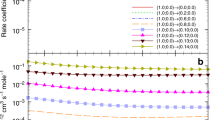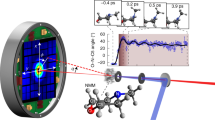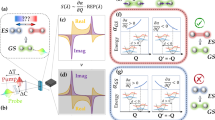Abstract
Experimental developments continue to challenge the theoretical description of molecular interactions. One key arena in which these advances have taken place is in rotationally inelastic scattering. Electric fields have been used with great success to select the initial quantum state and slow molecules for scattering studies, revealing novel stereodynamics, diffraction oscillations and scattering resonances. These have enjoyed excellent agreement with quantum scattering calculations performed on state-of-the-art coupled-cluster potential energy surfaces. To date these studies have largely employed reactants in the ground vibrational state (v = 0) and the lowest low-field-seeking quantum state. Here we describe the use of stimulated emission pumping to prepare NO molecules in arbitrary single rotational and parity states of v = 10 for inelastic scattering studies. These are employed in a near-copropagating molecular beam geometry that permits the collision energy to be tuned from above room temperature to 1 K or below, with product differential cross-sections obtained by velocity map imaging. This extremely nonequilibrium condition, not found in nature, tests current theoretical methods in a new regime.

This is a preview of subscription content, access via your institution
Access options
Access Nature and 54 other Nature Portfolio journals
Get Nature+, our best-value online-access subscription
$29.99 / 30 days
cancel any time
Subscribe to this journal
Receive 12 print issues and online access
$259.00 per year
only $21.58 per issue
Buy this article
- Purchase on Springer Link
- Instant access to full article PDF
Prices may be subject to local taxes which are calculated during checkout





Similar content being viewed by others
Data availability
Raw scattering images, MC simulated images, extracted DCSs and theoretical DCSs are publicly available in the Zenodo data repository at https://doi.org/10.5281/zenodo.3703096.
Code availability
The quantum 2D scattering algorithm used for open-shell systems such as Ar-NO is publicly available. The MC forward-convolution program used to simulate experimental conditions is available from the author upon reasonable request.
References
Nielson, G. C., Parker, G. A. & Pack, R. T. Intermolecular potential surfaces from electron gas methods. II. Angle and distance dependence of the A′ and A″ Ar–NO(X2Π) interactions. J. Chem. Phys. 66, 1396–1401 (1977).
Alexander, M. H. Rotationally inelastic collisions between a diatomic molecule in a 2Π electronic state and a structureless target. J. Chem. Phys. 76, 5974–5988 (1982).
Alexander, M. H. Quantum treatment of rotationally inelastic collisions involving molecules in Π electronic states: new derivation of the coupling potential. Chem. Phys. 92, 337–344 (1985).
Alexander, M. H. Differential and integral cross sections for the inelastic scattering of NO (X2Π) by Ar based on a new ab initio potential energy surface. J. Chem. Phys. 99, 7725–7738 (1993).
Alexander, M. H. A new, fully ab initio investigation of the NO(X2Π)Ar system. I. Potential energy surfaces and inelastic scattering. J. Chem. Phys. 111, 7426–7434 (1999).
Tsuji, K., Shibuya, K. & Obi, K. Bound–bound A2Σ+–X2Π transition of NO–Ar van der Waals complexes. J. Chem. Phys. 100, 5441–5447 (1994).
Parsons, B. F., Chandler, D. W., Sklute, E. C., Li, S. L. & Wade, E. A. Photodissociation dynamics of ArNO clusters. J. Phys. Chem. A 108, 9742–9749 (2004).
Sumiyoshi, Y. & Endo, Y. Intermolecular potential energy surface of Ar–NO. J. Chem. Phys. 127, 184309 (2007).
Kłos, J., Alexander, M. H., Hernández-Lamoneda, R. & Wright, T. G. Interaction of NO(A2Σ+) with rare gas atoms: potential energy surfaces and spectroscopy. J. Chem. Phys. 129, 244303 (2008).
Castro-Palacio, J. C., Ishii, K., Rubayo-Soneira, J. & Yamashita, K. An ab initio study of the Ar–NO(A2Σ+) intermolecular potential. J. Chem. Phys. 131, 044506 (2009).
Roeterdink, W. G., Strecker, K. E., Hayden, C. C., Janssen, M. H. M. & Chandler, D. W. Imaging the rotationally state-selected NO(A,n) product from the predissociation of the A state of the NO–Ar van der Waals cluster. J. Chem. Phys. 130, 134305 (2009).
Holmes-Ross, H. L. & Lawrance, W. D. The binding energies of NO–Rg (Rg = He, Ne, Ar) determined by velocity map imaging. J. Chem. Phys. 135, 014302 (2011).
Cybulski, H. & Fernández, B. Ab initio ground- and excited-state intermolecular potential energy surfaces for the NO–Ne and NO–Ar van der Waals complexes. J. Phys. Chem. A 116, 7319–7328 (2012).
Bontuyan, L. S., Suits, A. G., Houston, P. L. & Whitaker, B. J. State-resolved differential cross sections for crossed-beam argon-nitric oxide inelastic scattering by direct ion imaging. J. Phys. Chem. 97, 6342–6350 (1993).
Suits, A. G., Bontuyan, L. S., Houston, P. L. & Whitaker, B. J. Differential cross sections for state‐selected products by direct imaging: Ar+NO. J. Chem. Phys. 96, 8618–8620 (1992).
Kohguchi, H., Suzuki, T. & Alexander, M. H. Fully state-resolved differential cross sections for the inelastic scattering of the open-shell NO molecule by Ar. Science 294, 832–834 (2001).
Lorenz, K. T. et al. Direct measurement of the preferred sense of NO rotation after collision with argon. Science 293, 2063–2066 (2001).
Elioff, M. S. & Chandler, D. W. State-to-state differential cross sections for spin–multiplet-changing collisions of NO(X2Π1/2) with argon. J. Chem. Phys. 117, 6455–6462 (2002).
Wade, E. A. et al. Ion imaging studies of product rotational alignment in collisions of NO (X2Π1/2, j = 0.5) with Ar. Chem. Phys. 301, 261–272 (2004).
Kim, Y. & Meyer, H. Multiphoton spectroscopy of NO-Rg (Rg = rare gas) van der Waals systems. Int. Rev. Phys. Chem. 20, 219–282 (2001).
Eyles, C. J. et al. The effect of parity conservation on the spin–orbit conserving and spin–orbit changing differential cross sections for the inelastic scattering of NO(X) by Ar. Phys. Chem. Chem. Phys. 14, 5420–5439 (2012).
Brouard, M. et al. Differential steric effects in the inelastic scattering of NO(X) + Ar: spin–orbit changing transitions. Phys. Chem. Chem. Phys. 21, 14173–14185 (2019).
van Leuken, J. J., van Amerom, F. H. W., Bulthuis, J., Snijders, J. G. & Stolte, S. Parity-resolved rotationally inelastic collisions of hexapole state-selected NO (2Π1/2, J = 1/2-) with Ar. J. Phys. Chem. 99, 15573–15579 (1995).
Gijsbertsen, A. et al. Differential cross sections for collisions of hexapole state-selected NO with He. J. Chem. Phys. 123, 224305 (2005).
Eyles, C. J. et al. Interference structures in the differential cross-sections for inelastic scattering of NO by Ar. Nat. Chem. 3, 597–602 (2011).
Eyles, C. J. et al. Fully Λ-doublet resolved state-to-state differential cross-sections for the inelastic scattering of NO (X) with Ar. Phys. Chem. Chem. Phys. 14, 5403–5419 (2012).
Gilijamse, J. J., Hoekstra, S., van de Meerakker, S. Y. T., Groenenboom, G. C. & Meijer, G. Near-threshold inelastic collisions using molecular beams with a tunable velocity. Science 313, 1617–1620 (2006).
Kirste, M. et al. Quantum-state resolved bimolecular collisions of velocity-controlled OH with NO radicals. Science 338, 1060–1063 (2012).
von Zastrow, A. et al. State-resolved diffraction oscillations imaged for inelastic collisions of NO radicals with He, Ne and Ar. Nat. Chem. 6, 216–221 (2014).
Vogels, S. N. et al. Imaging resonances in low-energy NO-He inelastic collisions. Science 350, 787–790 (2015).
Onvlee, J. et al. Imaging quantum stereodynamics through Fraunhofer scattering of NO radicals with rare-gas atoms. Nat. Chem. 9, 226–233 (2016).
Rubahn, H. & Bergmann, K. The effect of laser-induced vibrational bond stretching in atom-molecule collisions. Annu. Rev. Phys. Chem. 41, 735–773 (1990).
Dixit, A. A., Pisano, P. J. & Houston, P. L. Differential cross section for rotationally inelastic scattering of vibrationally excited NO(v=5) from Ar. J. Phys. Chem. A 105, 11165–11170 (2001).
Amarasinghe, C. et al. Differential cross sections for state-to-state collisions of NO (v = 10) in near-copropagating beams. J. Phys. Chem. Lett. 10, 2422–2427 (2019).
Hamilton, C. E., Kinsey, J. L. & Field, R. W. Stimulated emission pumping: new methods in spectroscopy and molecular dynamics. Annu. Rev. Phys. Chem. 37, 493–524 (1986).
Yang, X. & Wodtke, A. M. Efficient state‐specific preparation of highly vibrationally excited NO(X2Π). J. Chem. Phys. 92, 116–120 (1990).
Yang, X., Kim, E. H. & Wodtke, A. M. Vibrational energy transfer of very highly vibrationally excited NO. J. Chem. Phys. 96, 5111–5122 (1992).
Chen, J., Matsiev, D., White, J. D., Murphy, M. & Wodtke, A. M. Hexapole transport and focusing of vibrationally excited NO molecules prepared by optical pumping. Chem. Phys. 301, 161–172 (2004).
Townsend, D., Minitti, M. P. & Suits, A. G. Direct current slice imaging. Rev. Sci. Instrum. 74, 2530–2539 (2003).
Jeziorska, M., Jankowski, P., Szalewicz, K. & Jeziorski, B. On the optimal choice of monomer geometry in calculations of intermolecular interaction energies: rovibrational spectrum of Ar–HF from two- and three-dimensional potentials. J. Chem. Phys. 113, 2957–2968 (2000).
Rutkowski, M. & Zacharias, H. Depolarisation of the spatial alignment of the rotational angular momentum vector by hyperfine interaction. Chem. Phys. 301, 189–196 (2004).
McCurdy, C. W. & Miller, W. H. Interference effects in rotational state distributions: propensity and inverse propensity. J. Chem. Phys. 67, 463–468 (1977).
Korsch, H. J. & Schinke, R. A uniform semiclassical sudden approximation for rotationally inelastic scattering. J. Chem. Phys. 73, 1222–1232 (1980).
Korsch, H. J. & Schinke, R. Rotational rainbows: an IOS study of rotational excitation of hard‐shell molecules. J. Chem. Phys. 75, 3850–3859 (1981).
Amarasinghe, C. & Suits, A. G. Intrabeam scattering for ultracold collisions. J. Phys. Chem. Lett. 8, 5153–5159 (2017).
Abeysekera, C. et al. Note: a short-pulse high-intensity molecular beam valve based on a piezoelectric stack actuator. Rev. Sci. Instrum. 85, 116107 (2014).
Ho, T. S. & Rabitz, H. A general method for constructing multidimensional molecular potential energy surfaces from ab initio calculations. J. Chem. Phys. 104, 2584–2597 (1996).
Acknowledgements
We thank S. Y. T. van de Meerakker for valuable discussions. This work was supported by the Army Research Office under awards W911NF-14-1-0378 and W911NF-19-1-0283 and the AFOSR under award FA9550-16-1-0018. J.K. acknowledges financial support from the US National Science Foundation, grant no. CHE-1565872 to Millard Alexander. M.B. acknowledges support from the Dutch Astrochemistry Network programme of the Netherlands Organization for Scientific Research and support from the European Research Council under the European Union’s Horizon 2020 Research and Innovation Program (grant agreement no. 817947 FICOMOL awarded to S. Y. T. van de Meerakker).
Author information
Authors and Affiliations
Contributions
The project was conceived by A.G.S. The experiments were carried out by C.A., H.L. and C.P. Data analysis and simulations were performed by C.A. The RCCSD(T)-F12 potential energy surfaces were calculated by J.K. Scattering calculations employing the RCCSD(T)-F12 PESs were performed by M.B. under the guidance of G.C.G. and A.v.d.A. MRCI calculations were performed by J.Z. and C.X. under the supervision of H.G. The paper was written by C.A. and A.G.S. with contributions from all the authors.
Corresponding author
Ethics declarations
Competing Interests
The authors declare no competing interests.
Additional information
Publisher’s note Springer Nature remains neutral with regard to jurisdictional claims in published maps and institutional affiliations.
Supplementary information
Supplementary Information
Supplementary Figs. 1–13, computational methods, supporting experimental data, data analysis and Tables 1–3.
Rights and permissions
About this article
Cite this article
Amarasinghe, C., Li, H., Perera, C.A. et al. State-to-state scattering of highly vibrationally excited NO at broadly tunable energies. Nat. Chem. 12, 528–534 (2020). https://doi.org/10.1038/s41557-020-0466-8
Received:
Accepted:
Published:
Issue Date:
DOI: https://doi.org/10.1038/s41557-020-0466-8
This article is cited by
-
Mapping partial wave dynamics in scattering resonances by rotational de-excitation collisions
Nature Chemistry (2022)
-
Towards chemistry at absolute zero
Nature Reviews Chemistry (2021)



